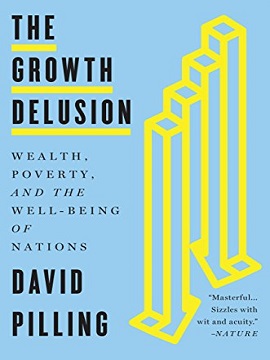Business Standard reported on August 16 that “India’s GDP (is) expected to grow at 7.4% in FY19”;1 to the general population this statement brings in a wave of optimism regarding not just the economy of the country but also a sense of progress in the well-being of the people of India. It gives away a vibe of progress that is so general in its scope that it’s difficult to ascertain what this growth rate actually means. It’s against such blind optimism that David Pilling writes “The Growth Delusion”.
We have to laud David Pilling for his writing style, even a layman would find no trouble understanding the complications often associated with economics; in fact he speaks out against Gradgrindian economists who are constantly on the lookout for tangible outcomes. Economy to these economists (who also determine public policy) comprises mostly of monetary transactions in which parties willingly consent to take part. In doing so, however, it cannot distinguish between “good” and “bad” activity. Some examples include the drastic fall of 5% in the Columbian economy after Pablo Escobar’s demise or Italy’s economy overtaking Britain’s with an 18% jump due to taxing of Grey economy. The GDP, Pilling argues, is good with crunching numbers but does not really account for the wellbeing of the people.
David Pilling links the way we calculate and project our progress to recent political transformations. He argues that it is not global inequalities that have caused Brexit or the election of Donald Trump, but the inequalities within a country that have led to these. He elucidates that because people do not see the reality of their lives projected in the official numbers, there exists a sense of injustice, of being left behind, when actually by conventional measures, these countries have never been as rich as they are today. Pilling then goes on to elaborate on various shortfalls of GDP, where on the one hand, stolen goods contribute to GDP, unpaid work such as housework doesn’t. He illustrates how Abe’s plan of getting women to work from unpaid housework to a taxable workforce marginally impacted the economy and about how women may negatively impact growth rates just by feeding breastmilk for the first 6 months after birth.
Public services are specifically what national accounts find hard to make sense of. Measurements could only be made of the monetary aspects of these services resulting in a public policy that focuses not on the unquantifiable outcomes to be visible in the long run, but on these services as a means to create a higher economic growth in the short term; hence mostly breeding in-efficiency in pursuit of inflated growth. Since GDP was primarily a mean to measure physical production, service sectors are increasingly finding it difficult to make sense of the GDP connection. The service sector tends to wipe out the transactional costs which are being measured, replacing them with convenience which is not measured; i.e. in conventional ways of measuring it is shrinking the GDP, when essentially welfare is on the rise. A service like Airbnb expands convenience, but at the same time results in contraction in requirement for hotel services. This contraction brings down construction at the same time making available cheaper rooms, increasing efficiency while also negatively impacting the economy.
In the last few chapters, Pilling takes us through all the other measures of wellbeing also mentioning their shortfalls. But the key point to be taken into account, notwithstanding their shortfalls, is that these measures are at least making an effort at measuring ‘wellbeing’ while GDP tends to remain averse. Happiness Index , Genuine Progress Index, Green Growth, Human Development Index and the Canadian Index of Wellbeing, all try to swing the over emphasis that economic growth enjoys to well-being. The Canadian Index of Wellbeing is particularly interesting since it is comprised of the desires of its own population based on surveys, owing to the fact that aspects of wellbeing drawn in high offices may be very subjective in nature. Hence an index based on what a country values more rather than vague economic growth figures is much more desirable.
In the last chapter, Pilling states that the genius of GDP is that it is able to squeeze all human activity into a single number for policy makers to act on, but this is also its biggest flaw. To quote, “no single number can capture all that is worth knowing in life”, and adding to it somewhat mockingly, “even if you’re an economist”. On the other hand, he also mentions in the previous chapters that economic growth could be liberating for people living in countries like India, pursuit of which has resulted in transformation of millions of lives. Precisely because of this, his intention is not for the GDP to be scrapped but to add to it measures such as GDP Per Capita, Inequality, Wellbeing, and CO2 emission. GDP must not be seen as an end in itself but a means to improve people’s lives.
‘The Growth Delusion’ is an insightful book, it helps us better understand and analyse aspects of wellbeing that we tend to overlook in a feverish haste for economic growth. In that process, what gets measured is what matters and what isn’t - such as Pollution, environmental damage and housework - does not. It is a sobering read, in that it helps us understand that not all growth is good and absence of it is not necessarily bad. It inquiries into our habit of seeing everything through the prism of economic growth and most important of it all, it makes us question, like Simon Kuznets did, “What are we growing? And why?”











Post new comment